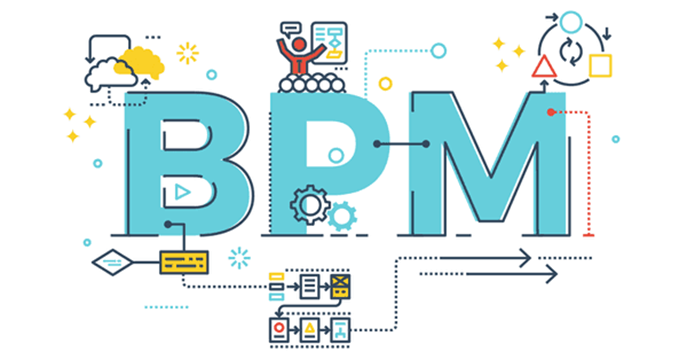In its definition, business process management is a set of software that serves to support the automation of all business processes. Today it is clear that BPM is a layer of Process Abstraction. In contrast to the popular Workflow a decade ago, which mainly uses the first type of interaction: Man-Man (Document-Oriented Interaction) and almost does not affect the System-System interaction (Data-Oriented Interaction) and Man-System (Documents and Data), while BPM integrates all of these three types of actions.
At the same time, the main difference and advantage of BPM is the ability of such software to integrate a very fragmented set of activities into a single system, the ability to coordinate large-scale business operations that often go beyond the scope of an application or department. Modern BPM solutions have grown out of ideology when each application is responsible for a specific set of processes and coordinates the work of related applications for the efficient operation of processes.
Today, BPM takes control of processes from individual applications and makes them equal participants who obey the work of the BPM layer responsible for the execution of operations. In such cases, the advanced BPM available at www.creatio.com delegates applications to complete tasks or perform certain actions by their specialization. Thus, the very first wording can be rephrased in favor of: “BPM can be called the main control layer that coordinates the processes in all applications with which it is integrated.”
This approach includes, but is not limited to, functions and functionalities that combine your company data into a single database, a variety of data segmentation tools, as well as process modeling, monitoring, and execution for complete optimization. No matter how simple or complex your task may be, a good BPM platform will give you what you need to optimize your processes.
Becoming a Modern BPM

Historically, several approaches to the creation of various BPMs have been formed, which reflect a different degree of resistance of companies when business processes can slow down when introducing new software products.
At the same time, companies have several alternatives for implementing BPM systems. Two of them, described below, represent two diametrically opposite ways to implement BPM:
Ready-made BPM application package or framework. These products are complete applications with functionality “from and to,” from modeling and simulation to optimization and execution.
Embedded BPM engines. The company integrates these mechanisms into existing applications or new development initiatives. They can work in diverse heterogeneous configurations but come with minimum infrastructure, in particular, with a data warehouse.
BPM development ideologists argue that the first approach is more viable and comprehensive and is suitable for those organizations that want a ready-made solution. The second approach cannot be used immediately, without additional integration, and is ideal for companies that prefer to build a BPM solution themselves, or for suppliers who require BPM functionality for use, for example, in a document management package.
Today, such issues have already disappeared from the practice of BPM solutions. Because of numerous organizations have trusted the intuition of advanced vendors and made their choice in favor of a new ideology. They have been much better than those who adhered to approaches of small process integration.
Advanced BPM Solutions for Your Business
Each of the many business sectors uses specialized software in their work, often from different suppliers, because in various issues and areas of competence, each company finds its best. At the same time, any company would like to receive the most integrated expert-grade BPM products for its purposes due to the higher degree of integration and more benefits that your employees will receive as a result of increased efficiency and usability.
Creatio’s advanced marketing platforms already work in many industries. These numerous examples of successful software purchases provide most enterprises with the best solutions for successfully integrating business processes. At the same time, the best support for your entire business occurs.
After all, such an advanced software that manages customer relationships in essence, which can significantly speed up your company’s business processes. Market accelerates when your employees can access the company’s system from any device or web browser to provide the best service for your customers.
At the same time, you are free from many routine but critical processes and can focus on strategic decisions to promote your business in the market.
Invest in Raising Revenues

Research shows that the rise in productivity experienced when implementing proper business process management directly affects revenue. Streamlining business processes can increase your return on investment on the BPM software itself by as much as 41% while at the same the heightened efficiency lowers costs across the board.
As you learn to implement better, more intelligent processes for accelerating business, the out-to-expense ratio drops significantly at the same time.
How BPM Software Helps Your Business
The method of business process optimization involves designing various norms to bring into line the different processes parameters with your firm’s business objectives and creation of tools for the consistent processes development based on the extent of these objectives achievement. Company performance indicators are used as these criteria. So if you want a flourishing business, then optimizing your business processes will allow your business to step many steps forward in the path to success.
When you use a leading solution such as the software from Creatio, you’ll soon learn the actual definition business process management embodies when carefully designed. All good BPM software is built around a backend of customer relationship management components that supplies a powerful toolset to all levels of staff.
The value rises even more when you opt for a low code platform that lets team leaders speed up their day-to-day tasks without extensive training. Yet, these are not the only benefits. You can expect:
- Automation of all and any day-to-day repetitive tasks with very low difficulty
- Faster case resolution with total company transparency for better management
- Visualization and optimization of any internal workflow including integrations
- Increased efficiency and productivity across the entire workplace
- Greater employee workplace satisfaction & more time devoted to the growth
- Software that encourages collaboration and competition while maintaining a right level of transparency
- Low code process development for rapid solutions and effortless acceleration of any existing or new cycle
Most successful BPM solutions incorporate the following components:
- Business Process Mapping – modeling the core processes and interdependencies
- Business Rules Engine – encapsulating procedural rules and decisions
- Workflow Automation – routing information to the right people at the right time
- Application Integration – middleware that enables data exchange between software
- Knowledge Base – data repository that stores business rules and other information
- Business Activity Monitoring – a system that monitors all activities in a process
Solutions for Any Complexity & Any Improvement
There’s no funnel, workflow, or course of actions making up a tactical step that is too complicated. From simple things like document queue management to bulk mailing campaigns automated and each tailored to a specific demographic – reasonable BPM solutions can do it all.
Visual design tools with libraries packed with out-of-the-box processes can be expected, while superior platforms will let you handle unstructured processes as well.


















